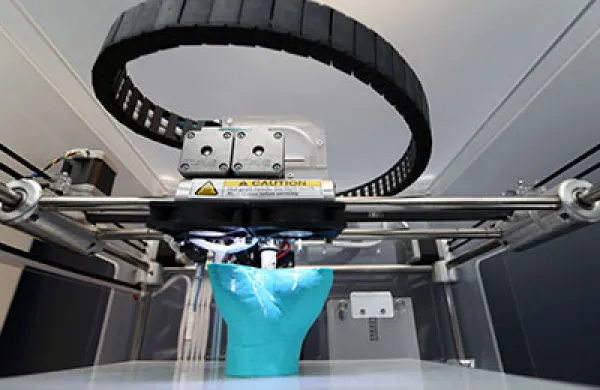On Monday, July 18, an African penguin at Mystic Aquarium in Mystic, Connecticut, took her first steps with a new mobility boot crafted by 3D Systems. The event for the penguin made for adorable pictures, and was also an opportunity for the Rock Hill, South Carolina–based 3-D printing company to tout the medical uses of its products for both animals and humans. But the penguin excitement was pushed aside by less flattering news that day when Piper Jaffray downgraded the company’s rating to underweight from neutral, citing a recent slump in 3-D printer demand. After that announcement, 3D Systems stock plummeted 8 percent, while its rival Stratasys, which also got downgraded, sank 9 percent.
Neither company’s stock has performed well this year, and these falls come within the context of several years of volatility for an industry that promises technological transformation of industries from medicine to manufacturing but is having trouble proving its relevance to many investors. By one measure — Kensho Technologies’ 3-D Printing Index, which tracks 3-D printer makers, firms that produce the components for 3-D printers and those that create the necessary software — the sector is down more than 32 percent over the past three years. And according to Piper Jaffray, the industry just had its worst quarter yet in terms of demand for 3-D printing systems. In the meantime, tech giants such as HP and Dell have entered the 3-D printing fray, using their established clout and resources to avoid being fully disrupted. Why, then, did ARK Investment Management, a New York–based registered investment adviser that offers a range of proprietary exchange-traded funds, choose July 18, to launch the first and only solely 3-D printing–focused ETF?
“This is classic disruptive innovation,” says Catherine Wood, founder, CEO and CIO at ARK. “If you look at the S curve, you go through a height phase, a consolidation and restructuring phase — which we’ve just been through — and then takeoff. We think we’re in the saddle phase, getting ready for takeoff.”
The new ETF — PRNT — is listed on the BATS ETF Marketplace and includes 3D Systems, Stratasys, ExOne Co. and Organovo Holdings, as well as HP. It’s proof that whereas some investors have given up on the industry, many are still holding out hope for a 3-D revolution. ARK is not alone in believing the 3-D printing slowdown is temporary, and it is in fact an expected part of the disruptive process. The Consumer Technology Association recently predicted that the industry would approach $5 billion in sales by 2017, up from $1.7 billion in 2011, and argued that it will have “a greater impact on the world over the next 20 years than all of the innovations from the Industrial Revolution combined.”
The growing pains have been lengthy, and they may have been exacerbated by missteps by some of the major players, including Stratasys. Wood believes that the Eden Prairie, Minnesota– and Rehovot, Israel–based company chose the wrong time to buy Brooklyn-based consumer 3-D printer brand MakerBot Industries in 2013, which turned out to be the peak of the market in terms of stock prices. The firm has spent the past year restructuring and downsizing and has since outsourced production of MakerBot’s machines to China. But Wood and others argue that consumer printers, and the idea of every family having one in their home to print toys and other gadgets, are a distraction. Even prototyping is thinking too small, according to analysts at ARK, which estimates a $500 billion market for 3-D printing of parts for end products such as aircraft, shoes and medical tools. Companies such as Nike and Airbus are currently wading in to that “final frontier” of the market, according to ARK analyst Tasha Keeney.
“I think we are less than 1 percent penetrated in the end-user part market,” says Keeney.
HP’s foray into the 3-D printing market, which analysts have blamed for at least part of 3D Systems’ and Stratasys’ recent slump, has been focused on commercial use of 3-D printers. In May the company unveiled the HP Jet Fusion 3D Printing Solution, which it claims will make it easier and cheaper to create prototypes, as well as manufacture final parts. Nike, BMW, Johnson & Johnson, Autodesk and several other technology, retail and manufacturing firms have partnered with HP to help further develop its 3-D printing system, according to the company. This will necessarily put pressure on pure 3-D printing companies, and some consolidation wouldn’t be surprising, says Nick Kramer, senior director of data and analytics at New York–based management consulting firm SSA & Co. He believes the real opportunity in the industry hasn’t passed; it’s about to come into view.
“The cool factor has certainly gone away, but I think now a lot of things are coming together to make 3-D printing ready for actual practical usage, adding value to the world,” Kramer says. “If anything, I’m more bullish than ever on the future of 3-D printing.”
The industry’s biggest issue, and the reason its “disillusionment period,” as Kramer calls it, has been painful for some companies, is that 3-D printers are truly a commodity that isn’t worth much on its own, except for hobbyists. As other industries start to plug 3-D printing into their supply chain, and the Internet of Things capabilities of 3-D printed components become more clear — replacing parts on smart devices, for example, or printing out a purchase from Amazon seconds after ordering — demand is expected to shoot right back up. The question is, Which companies will be best positioned to sell them?
Follow Kaitlin Ugolik on Twitter: @kaitlinugolik.





